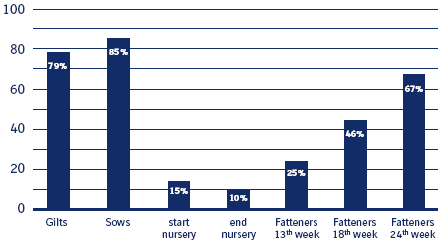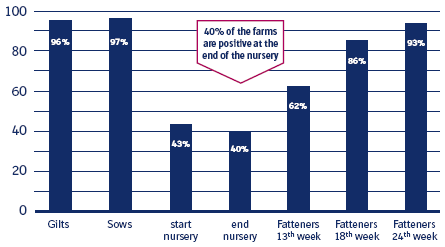2.1.1 What is the prevalence of L. intracellularis infection in European farms?
The average European seroprofile shows the highest percentage of positive serum samples in gilts and sows (79% and 85%, respectively). The lowest prevalence was found in piglets at the start and at the end of the nursery (15% and 10%, respectively) (Figure 2.1.1a). Piglets at the start of the nursery (3rd/4th week of life) showed consistently more positive serum samples than those at the end of the nursery. This is expected since maternal antibodies, present at weaning, disappear in most cases by week 6 of life (Wendt and Schulze-Johann 2004). The within farm correlation between the ELISA value of sows and the ELISA values of piglets at the start of the nursery was as high as r=0.64 (p<0.001). Therefore it is reasonable to assume that a part of these antibodies at the start of the nursery are of maternal origin.
With the start of the fattening period a clear increase in the prevalence from 10% to 25% was found in the average European seroprofile. The seroconversion starts between the end of the nursery and the 13 th week of life. Considering about 2 to 3 weeks from infection to seroconversion (Just et al. 2001; Guedes and Gebhart 2003) the pigs are infected in the nursery or short after introduction into the fattening units in the majority of European farms (Figure 2.1.1a and 2.1.1b). In the 13th week of life, each 4th pig in Europe is already infected with L. intracellularis. Thereafter, a nearly linear increase in the percentage of positive samples towards the end of the fattening is observed. Close to marketing, as much as two out of three animals are infected. Any signs of suboptimal growth, compromised feed conversion and increased weight variation between the 13th week of life and slaughter will significantly effect the economic results of pig production in Europe.
Keeping in mind that L. intracellularis antibodies are with 4 to 5 weeks relatively short-lived (Just et al. 2001; Marsteller et al. 2003), it can be assumed that the observed infection pattern is due to a relatively slow re-exposure of an increasing number of infected animals. Interestingly, in outdoor production units where the chances for re-exposure are lower, the infection risk and the seroprevalence are significantly lower than in intensive managed indoor production units with a higher chance of re-infection (Bronsvoort et al. 2001; Hagen and Bilkei 2003).
Compared to the average percentage of positive pigs within a farm, the average percentage of positive farms is much higher. On average between 93% of the fatteners and 97% of the sows of all farms in Europe are serologically positive (Figure 2.1.1b).

Figure 2.1.1 a
The average percentage positive pigs in different age groups on 342 European farms.

Figure 2.1.1 b
The average percentage positive farms in different age groups on 342 European farms.
The overall age-pattern of prevalence is in good agreement with the percentage of positive pigs within a farm. It is important to note that at the end of the nursery (8th to 10th week) already 40% of all European herds are infected with L. intracellularis. Compared to the European situation, the average herd in North America seems to reach this point much later. In the United States a herd prevalence of 40% is found between the 15th and the 18th week of life (Marsteller et al. 2003). This difference in the prevalence pattern may be partly influenced by the applied antibiotic feeding regimes or/and by differences in production system (higher number of multi site in the US compared to single site production systems in the EU). Nevertheless, this simple figure has important implications for the prevention of PPE in Europe regarding the timing of vaccination.
© Boehringer Ingelheim Animal Health GmbH, 2006
All rights reserved. No part of this Technical Manual 3.0 may be reproduced or transmitted in any form or by any means, electronic or photocopy, without permission in writing from Boehringer Ingelheim Animal Health GmbH.






